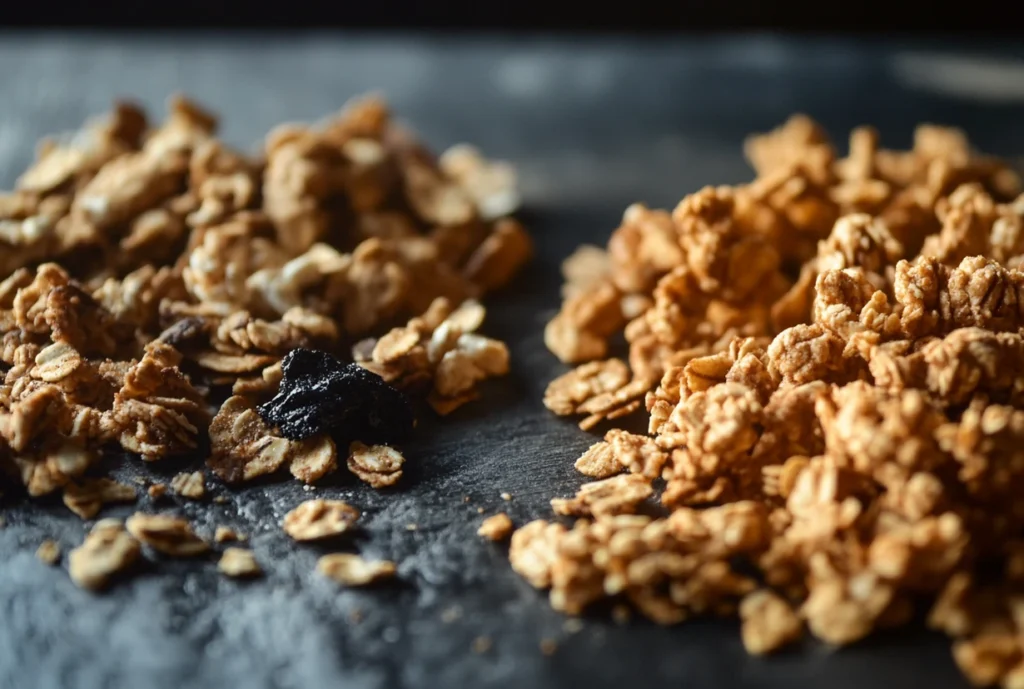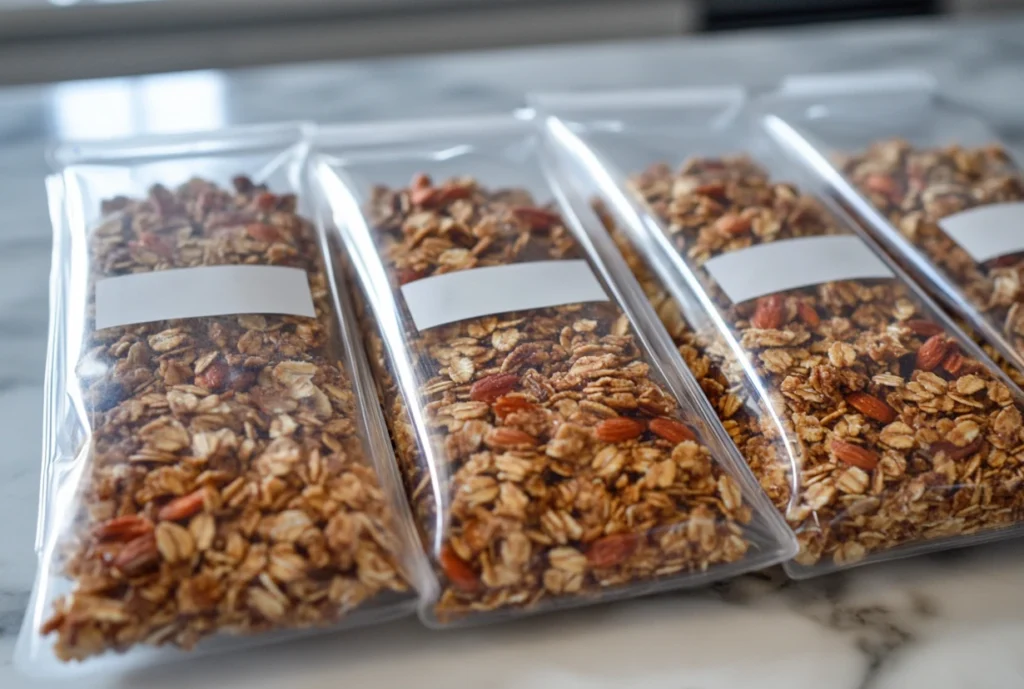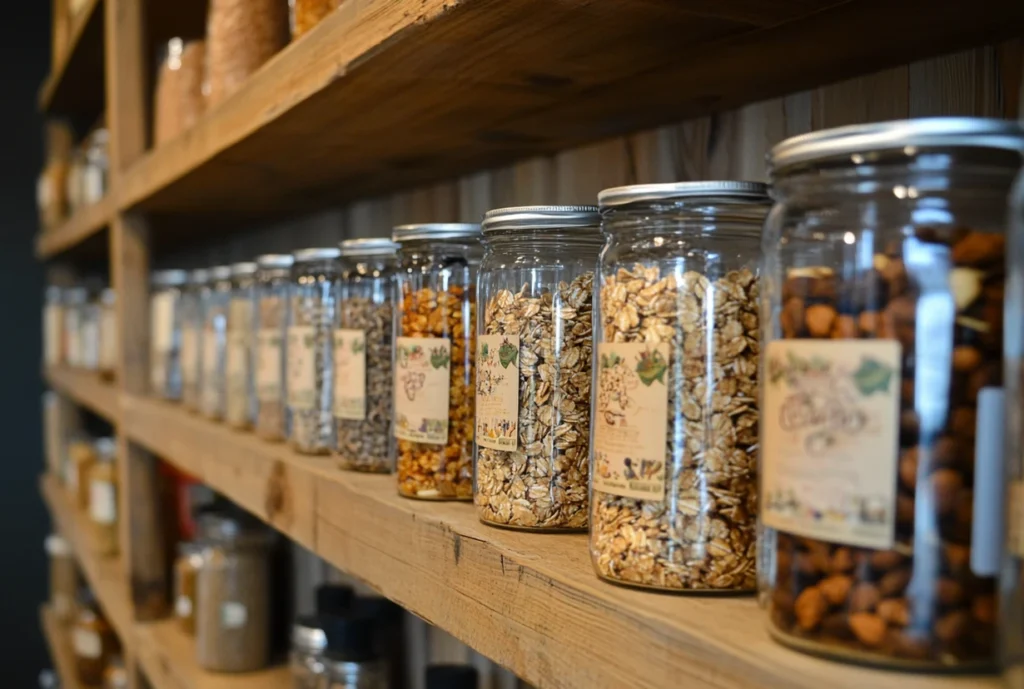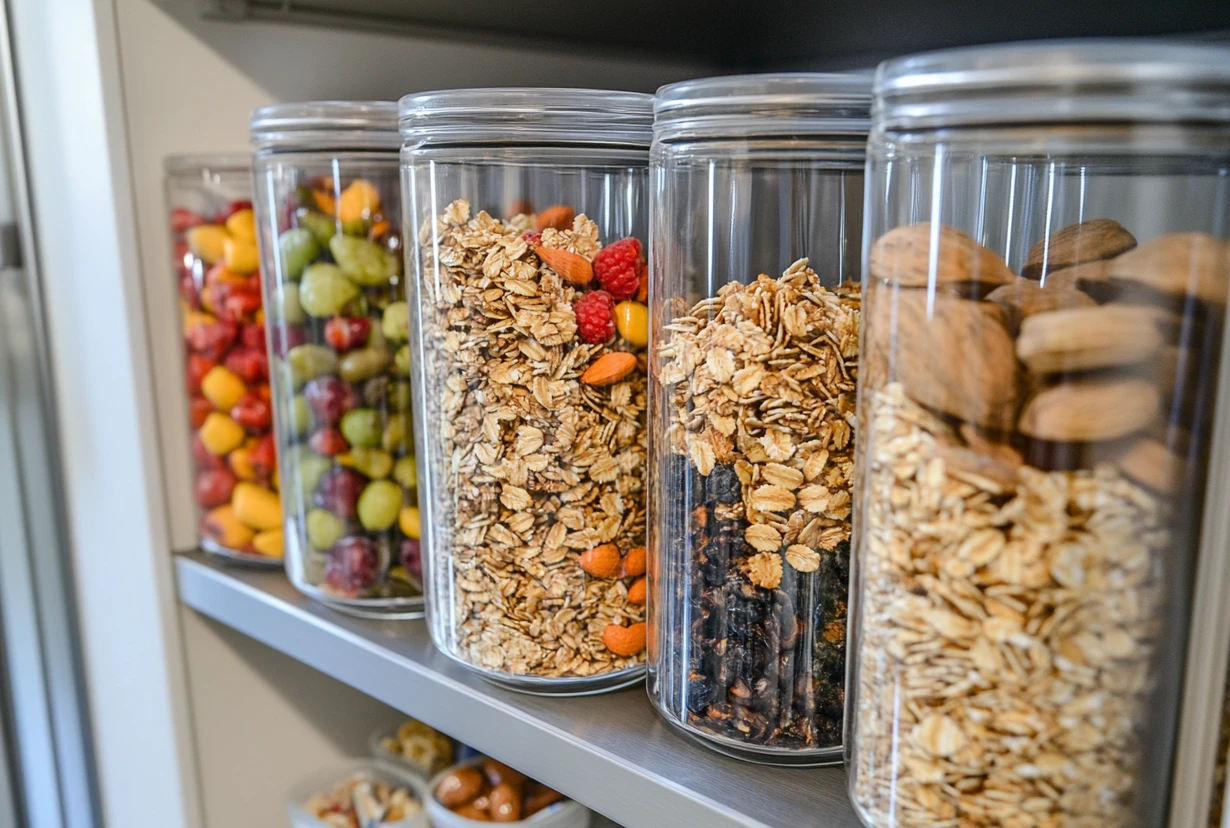Does granola need to be refrigerated? This question often arises for those who love this crunchy, versatile snack. Proper storage is key to maintaining its flavor, texture, and nutritional value. Whether you prefer it as a quick breakfast or a midday snack, understanding how to store granola can help you enjoy it at its best.
Does Granola Need to Be Refrigerated?
Granola is a beloved staple in many households, known for its delicious crunch, hearty ingredients, and versatility. Made from a mix of rolled oats, nuts, seeds, sweeteners, and often dried fruits, it’s baked to create a satisfying texture and flavor. Whether you enjoy it as a cereal, a topping for yogurt, or a snack on its own, granola is a convenient and nutritious choice. However, the way you store granola can significantly impact its freshness and taste over time.
A common question arises: Does granola need to be refrigerated? While refrigeration might seem like a logical way to preserve food, it’s not always necessary for granola. Understanding the ingredients, moisture levels, and storage conditions can help determine whether refrigeration is beneficial or if there are better ways to keep your granola fresh and crunchy. Let’s dive into the details and best practices for granola storage.
What is Granola?
A Nutritious Blend of Ingredients
Granola is a versatile food that has become a staple in kitchens worldwide. At its core, granola consists of rolled oats combined with nuts, seeds, sweeteners like honey or maple syrup, and often dried fruits or chocolate chips. This mix is baked to golden perfection, resulting in a crunchy, satisfying texture. Packed with carbohydrates, healthy fats, and fiber, granola is a go-to choice for those seeking a convenient, nutritious snack or breakfast.
From Health Food to Culinary Staple
Originally introduced as a health food, granola has since evolved to cater to a variety of preferences. It can be made gluten-free, sugar-free, or vegan, depending on the ingredients. Many enjoy it as a topping for yogurt, a smoothie mix-in, or simply as a snack on its own. Homemade granola, which allows for personalization of flavors and textures, has also gained popularity. However, the variety of ingredients in granola impacts its storage needs, raising the question: Does granola need to be refrigerated?
Granola Storage Basics
Why Proper Storage Matters
Granola’s appeal lies in its crisp texture and delightful combination of flavors. Proper storage is essential to maintain these qualities. Without appropriate storage, granola can lose its crunch, absorb moisture, or even spoil, particularly if it contains perishable add-ins like dried fruits or chocolate chips. By understanding the basics of granola storage, you can ensure that it stays fresh and delicious for as long as possible.
Ingredients That Influence Storage
The ingredients in granola play a significant role in determining how it should be stored. Rolled oats and nuts are relatively shelf-stable, but sweeteners and dried fruits can introduce moisture, which might compromise freshness over time. Additionally, homemade granola, which often lacks the preservatives found in store-bought varieties, may have a shorter shelf life and require more careful storage considerations.
General Guidelines for Granola Storage
Granola is best stored in a cool, dry place in an airtight container to protect it from air and moisture. This setup helps preserve its crunch and flavor. However, specific circumstances—such as high humidity or the inclusion of perishable ingredients—might require different storage approaches, such as refrigeration or freezing, to prolong freshness.
Room Temperature Storage
The Ideal Storage Setup
Storing granola at room temperature works well for most situations, especially when it is kept in a cool, dry environment. Here’s a quick guide to ensure your granola stays fresh:
| Factor | Best Practices |
|---|---|
| Container Type | Use airtight containers like glass jars, plastic tubs, or resealable bags to lock out moisture. |
| Storage Location | Place granola in a pantry or cabinet away from heat, light, and humidity. |
| Duration | Store granola for up to 2-3 weeks to enjoy maximum freshness and crunch. |
When Room Temperature Works Best
Room temperature is ideal for granola without perishable add-ins, such as chocolate chips or fresh fruit. It allows you to enjoy granola conveniently without the added hassle of refrigeration or freezing. If stored correctly in an airtight container, granola remains crisp and flavorful throughout its shelf life.
Avoid Common Pitfalls
Exposing granola to air, moisture, or temperature fluctuations can lead to staleness or loss of texture. For example, leaving granola open in a humid environment may cause it to soften, while exposure to sunlight can alter its flavor over time. Always reseal your container tightly after each use to keep your granola fresh.
Does Refrigerating Granola Make Sense?
Refrigeration: Pros and Cons
Refrigerating granola is not a standard practice, but there are scenarios where it might make sense. Here’s a breakdown of the benefits and drawbacks:
| Aspect | Advantages | Disadvantages |
|---|---|---|
| Prolonged Freshness | Refrigeration can extend the shelf life of granola, especially if it contains perishable items. | Moisture in the fridge can make granola lose its crispness unless stored in airtight containers. |
| Temperature Control | Protects granola in hot or humid climates. | Storing granola in the fridge can make it less convenient to access for everyday use. |
When Refrigeration is Useful
Refrigerating granola is particularly helpful in warm, humid conditions where room temperature storage might lead to faster spoilage. It’s also a good choice if your granola contains perishable ingredients like chocolate, fresh fruit, or dairy-based add-ins. Be sure to use airtight containers to prevent the granola from absorbing odors or moisture from the refrigerator.
Why It’s Often Unnecessary
For granola made with stable ingredients like oats, nuts, and dried fruits, refrigeration isn’t needed. Room temperature storage typically works well as long as the granola is kept in an airtight container and away from moisture. Refrigeration might actually compromise the texture of granola by introducing unwanted softness.
Does Moisture Affect Granola Quality?

The Impact of Moisture
Moisture is the biggest enemy of granola’s signature crunch. When exposed to humidity, granola absorbs water, leading to a soggy and less appetizing texture. This is especially problematic in areas with high humidity or when granola is stored improperly. Proper storage methods are essential to shield granola from moisture and preserve its crispness.
Preventing Moisture Contamination
Follow these tips to protect granola from moisture:
| Problem | Solution |
|---|---|
| Humidity in Storage | Always store granola in a completely airtight container. |
| Frequent Opening | Reseal the container tightly after each use to minimize air exposure. |
| Improper Location | Keep granola away from sinks, stoves, or other sources of moisture in the kitchen. |
Why Airtight Containers Matter
Airtight containers not only protect granola from air but also create a barrier against humidity. They are crucial in maintaining the crispness of granola, especially in regions prone to damp weather. Containers with silicone seals or resealable bags with tight closures work best for this purpose.
Signs of Moisture Damage
If granola appears clumpy, soft, or loses its crunch, it may have been exposed to moisture. While this doesn’t necessarily make it unsafe to eat, the texture and flavor will likely be less enjoyable. To refresh slightly softened granola, consider spreading it on a baking sheet and heating it in the oven for a few minutes at a low temperature.
Signs Your Granola Has Gone Bad
How to Identify Spoiled Granola
Granola has a long shelf life when stored properly, but it’s not immune to spoilage. Identifying the signs of bad granola can save you from an unpleasant experience or potential health risks. Common indicators include:
- Stale or Off Odor: A musty or rancid smell often indicates that the nuts or oils in granola have gone bad.
- Change in Texture: If granola feels excessively soft or sticky, it may have absorbed moisture.
- Mold Growth: Visible mold, often appearing on dried fruits or clumped areas, is a clear sign to discard granola immediately.
- Off Taste: A bitter or sour taste can signal rancidity, particularly in nuts or seeds.
Factors That Contribute to Spoilage
Granola’s ingredients can degrade over time due to exposure to air, moisture, or improper storage. Nuts and seeds, which are high in oils, are particularly prone to rancidity when not stored in a cool, dry environment. Additionally, sweeteners like honey or syrups can ferment under certain conditions, altering the granola’s taste and safety.
Shelf Life Expectations
Typically, granola stays fresh for 2-3 weeks when stored at room temperature in an airtight container. Homemade granola may have a shorter shelf life than store-bought versions because it often lacks preservatives. However, extending granola’s freshness is possible through proper storage techniques, refrigeration, or freezing.
What to Do with Spoiled Granola
If granola shows signs of spoilage, it’s best to discard it to avoid any potential health risks. For granola that’s simply lost its crunch but hasn’t spoiled, you can revive it by toasting it briefly in the oven at a low temperature.
Can You Freeze Granola?

Freezing as a Storage Option
Freezing granola is an excellent way to extend its shelf life, especially if you’ve made a large batch or want to preserve its freshness for future use. Proper freezing keeps granola fresh for up to 6 months, ensuring that its flavor and texture remain intact.
Steps to Freeze Granola
Follow these simple steps to freeze granola effectively:
- Choose an Airtight Container: Use resealable freezer bags or airtight containers to prevent freezer burn and protect granola from absorbing odors.
- Portion the Granola: Divide granola into smaller portions for convenience, especially if you plan to use it gradually.
- Label and Date: Write the date of freezing on the container or bag for easy reference.
- Seal and Store: Place the granola in the freezer, ensuring it is stored away from strong-smelling foods to avoid odor absorption.
Thawing and Using Frozen Granola
When ready to use, thaw granola at room temperature for about 15-30 minutes. If it feels slightly soft after thawing, spread it on a baking sheet and toast it in the oven at 300°F (150°C) for 5-10 minutes to restore its crunch.
Advantages and Drawbacks of Freezing
| Aspect | Advantages | Drawbacks |
|---|---|---|
| Extended Shelf Life | Keeps granola fresh for up to 6 months. | Requires additional storage space in the freezer. |
| Preserves Texture | Protects granola from becoming stale or soft when sealed properly. | Thawing and reheating may add extra steps before use. |
| Convenience | Allows for bulk preparation and long-term storage. | Freezer odors can seep in if not sealed tightly. |
Is Freezing Always Necessary?
Freezing granola is most beneficial for large batches or homemade varieties without preservatives. For smaller amounts consumed within a few weeks, room temperature storage in airtight containers is usually sufficient.
Best Practices for Storing Granola

Choosing the Right Containers
The container you choose plays a crucial role in preserving granola’s freshness and crunch. Airtight options like glass jars, resealable bags, or plastic containers with tight lids are the best choices. They protect granola from air, moisture, and odors that can compromise its quality. Avoid loosely covered bowls or containers without proper seals, as they allow exposure to humidity and contaminants.
Where to Store Granola
Location matters when storing granola. Keep it in a cool, dry place, such as a pantry or a kitchen cabinet away from heat sources like ovens or stoves. Direct sunlight can also degrade the quality of granola, so opt for shaded areas. In humid climates, consider refrigeration or freezing for long-term freshness, as moisture can quickly affect its texture.
How to Extend Shelf Life
- Divide into Portions: Separate granola into smaller portions to reduce repeated exposure to air when opening the container.
- Add a Moisture Absorber: Place a food-safe silica gel packet or a small piece of bread in the container to absorb excess moisture.
- Check Regularly: Periodically inspect your granola for signs of spoilage, such as an off smell or softened texture, and consume it promptly.
Granola Storage Tips for Travelers
If you’re packing granola for travel or outdoor adventures, opt for single-serve resealable bags. These keep portions fresh and are convenient for snacking on the go. Ensure the bags are sealed tightly to prevent exposure to air and moisture during transit.
Does Homemade Granola Need to Be Refrigerated?
Differences Between Homemade and Store-Bought Granola
Homemade granola offers the advantage of customization, allowing you to tailor flavors, textures, and ingredients to your liking. However, this lack of preservatives in homemade versions means it may not last as long as store-bought options. Store-bought granola often contains stabilizers and packaging designed to extend shelf life, making it less dependent on meticulous storage practices. But does granola need to be refrigerated when it’s homemade?
When Refrigeration Is Necessary for Homemade Granola
Refrigerating homemade granola is advisable if it includes ingredients like fresh fruit, dairy-based components, or natural oils that can spoil quickly. These add-ins increase the risk of spoilage if the granola is left at room temperature for an extended period. Keeping it in the refrigerator in an airtight container can extend its freshness by minimizing exposure to air and heat.
When Refrigeration Isn’t Required
For traditional homemade granola made with oats, nuts, seeds, sweeteners, and dried fruits, refrigeration isn’t typically necessary. Proper storage at room temperature in an airtight container works well for up to two weeks. Ensure it’s stored in a cool, dry location to prevent moisture-related issues.
How to Optimize Homemade Granola Storage
- Divide Your Batch: Portion homemade granola into smaller containers to avoid repeatedly exposing the entire batch to air.
- Freeze for Longer Storage: If you’ve made a large amount and won’t use it within two weeks, freezing is a better option than refrigeration.
- Monitor Ingredients: Keep an eye on any ingredients prone to spoiling, like nuts or natural oils, as they can go rancid faster in homemade granola.
Final Word: Does Granola Need to Be Refrigerated?
Whether granola needs refrigeration largely depends on its ingredients and how quickly it will be consumed. For most homemade recipes, proper room-temperature storage suffices, but for longer shelf life or perishable ingredients, refrigeration or freezing is the way to go.
Conclusion: Does Granola Need to Be Refrigerated?
After exploring the question, does granola need to be refrigerated, it’s clear that the answer depends on its ingredients and how you plan to use it. For most granola made from stable ingredients like oats, nuts, and dried fruits, room temperature storage in an airtight container works perfectly. However, if your granola contains perishable items like fresh fruit, dairy, or chocolate, refrigeration can help extend its freshness and prevent spoilage.
For homemade granola lovers, whether granola needs to be refrigerated also depends on your recipe. Without preservatives, homemade granola has a shorter shelf life, making refrigeration or freezing a great option for longer storage. If you’re making granola with classic ingredients, storing it in a cool, dry place should keep it crunchy and delicious.
If you’re looking for a homemade granola recipe to try, check out this Maple and Pecan Granola Recipe for a delightful morning treat. It’s a versatile recipe that can be stored easily, whether at room temperature or in the fridge.
Ultimately, answering does granola need to be refrigerated comes down to your specific granola type and personal preferences. With the right storage practices, you can enjoy your granola fresh and flavorful for weeks to come.

